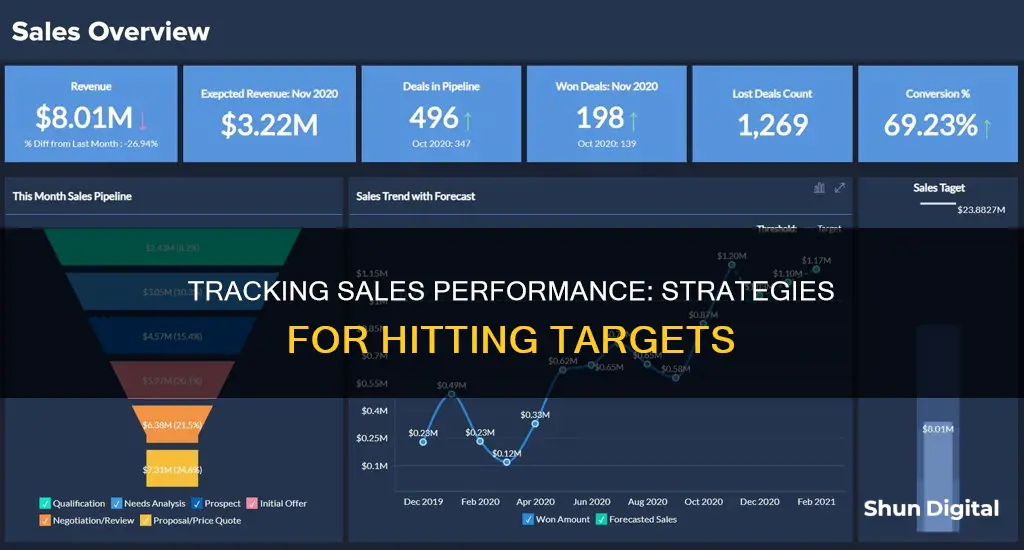
Monitoring sales performance against targets is a critical aspect of managing a sales team and driving business success. It involves tracking key metrics and indicators to evaluate how well the team is performing against predefined goals and objectives. This process provides valuable insights that enable data-driven decisions, optimise sales strategies, and ultimately, enhance overall performance.
By comparing current sales performance to targets or past performance, businesses can identify areas for improvement, make necessary adjustments, and ensure they stay on course to achieve their revenue and growth goals. This process is facilitated by sales analytics systems and tools that provide real-time data and visual representations of sales metrics.
Additionally, monitoring sales performance allows businesses to gain insights into customer behaviour, identify problem areas within the sales process, and make real-time adjustments to stay ahead of the competition. It also helps in evaluating the performance of individual team members, recognising achievements, and providing tailored support or incentives to improve motivation and productivity.
Overall, effective monitoring of sales performance against targets is a dynamic and continuous process that empowers businesses to make informed, data-driven decisions andsection sign the success of their sales strategies.
| Characteristics | Values |
|---|---|
| Frequency of monitoring | Daily, weekly, and monthly |
| Nature of targets | Dynamic and short-term focused |
| Visibility of targets | Visible to the whole team |
| Visuals | Bullet chart |
| Users | Sales directors, sales reps, executives, and sales managers |
| Formula | (Sales for the current period/Sales target) x 100 |
| Monitoring tools | Sales leaderboard, Salesforce dashboard, Dashboard gauge, Salesforce forecasts tab, Lightning Home Page Quarterly Performance Chart, GSP Target Tracker, Customized visual dashboard |
| Measurement | Revenue, units sold, or customer acquisition |
What You'll Learn

Measure current sales against a target or past performance
Monitoring sales performance against targets is a critical component of any successful business strategy. It helps measure business performance, provides insights into customer behaviour, identifies problem areas, and allows for real-time adjustments.
Set Clear Sales Targets:
- Determine your revenue goals by analysing your financial situation, historical sales data, market trends, and growth opportunities.
- Break down your revenue goals into smaller, more manageable monthly, quarterly, or annual sales targets. Ensure these targets are realistic and achievable.
Choose Key Performance Indicators (KPIs):
- Identify relevant KPIs that align with your sales targets. These could include revenue, customer acquisition, lead generation, conversion rates, etc.
- Ensure the KPIs are measurable, traceable, and visible, significantly impacting the success of your sales goals.
Implement a Customer Relationship Management (CRM) System:
- Utilise a CRM system to track and monitor sales performance effectively.
- A CRM system provides real-time visibility into your sales pipeline, identifies bottlenecks and areas for improvement, captures and stores customer data, and automates tedious tasks like data entry.
Set Up Sales Dashboards:
- Define the sales metrics you want to track, such as the number of leads generated, revenue per customer, or time taken to close a deal.
- Choose a dashboard software that offers customisation options and integrates with your existing sales tools.
- Build visually appealing dashboards using charts or graphs to represent your data. Update them frequently to reflect your current performance.
Monitor and Measure Regularly:
- Track your progress against sales targets regularly to gain insights and make adjustments.
- Use sales tracking tools, such as a sales leaderboard, to monitor individual and team performance.
- Review your performance against targets to identify gaps, trends, and areas for improvement.
Compare with Past Performance:
- Analyse historical sales data to compare current sales performance against past periods, such as the previous month, quarter, or year.
- Assess whether sales revenue was higher or lower than the target during those past periods.
Make Adjustments:
- Based on your analysis of current and past performance, identify areas where adjustments are needed.
- Adjust your sales strategy accordingly, such as changing sales techniques, improving customer relations, or optimising your sales pipeline.
By following these steps, you can effectively measure current sales against targets and past performance, enabling you to optimise your sales strategy and make data-driven decisions to improve overall sales performance.
Ankle Monitor Battery Life: How Long Does it Really Last?
You may want to see also

Monitor sales performance daily, weekly and monthly
Monitoring sales performance against targets is critical for a company's success and can impact revenue, profitability, and market share. Here are some ways to monitor sales performance daily, weekly, and monthly:
Daily
- Sales productivity: Track the total amount of revenue brought in and divide it by the number of sales employees. This provides a concise overview of how well each team member performs on average. Compare this metric with previous periods to identify any trends.
- Lead response time: Monitor how long it takes for sales reps to respond to a new sales lead. The faster the response, the higher the likelihood of converting the lead into a customer. Aim for a response time of five minutes or less.
- Quality of lead sources: Analyze where your leads are coming from and compare this data with client wins to determine if there are any strong relationships between certain lead sources and the odds of acquiring a new customer.
Weekly
- Number of unique contacts made: Measure the number of calls, emails, and live chats your reps initiate within a week. Use this data to understand your sales reps' current capacity and set weekly goals.
- Percentage of appointments set: Calculate the percentage of unique contacts that ended with an appointment. This metric shows your reps' ability to convert cold prospects into warm leads and move them down the sales pipeline.
- Time to reach out to a lead: Measure the length of time it takes reps to make contact with generated leads. A quick response time ensures that your team is reacting with urgency and prevents leads from getting away.
Monthly
- Number of Marketing Qualified Leads (MQLs): Track the amount of monthly leads that marketing has determined as "quality." This is a good starting point to gauge whether you've sourced enough good leads for your sales team to act on.
- Business Development Representative (BDR) capacity: Calculate the maximum number of daily leads multiplied by the number of business days in the month and the number of BDRs to determine the total number of leads your business development team can source in a month. Compare this with MQL targets to assess if your team is properly staffed.
- Account Executive (AE) capacity: Determine the maximum number of deals your account executives can handle in a month. Compare this with the number of monthly sales deals won to evaluate if your AEs are being utilized effectively.
By monitoring sales performance at different intervals, you can gain valuable insights into your team's performance, identify areas for improvement, and make data-driven decisions to enhance your sales strategies.
Uninstalling Rhino3D Installation Monitor: A Step-by-Step Guide
You may want to see also

Use a sales leaderboard and display it on a television
A sales leaderboard is a powerful tool for monitoring sales performance against targets. It is a simple yet effective way to track the progress of individual sales reps and the team as a whole.
A sales leaderboard can be displayed on a television screen, providing a clear and visible representation of sales performance. This approach offers several benefits:
Real-time Tracking
With a sales leaderboard, you can track individual sales performance and team sales performance in real-time. This allows for quick decision-making based on data, rather than waiting for quarterly reports. It also enables sales reps to instantly see how their work contributes to the overall target, fostering a deeper understanding of their impact.
Friendly Competition
A leaderboard encourages friendly competition among the sales team. This competitive element can fuel motivation, driving sales reps to perform better and potentially close more deals.
Transparency and Data-driven Culture
A television display ensures that the sales leaderboard is visible to the entire team, fostering transparency. This approach aligns with the principle that sales targets should be communicated clearly and made accessible to all team members. Moreover, it contributes to a data-driven culture, where decisions are informed by concrete metrics.
Quick Identification of Problem Areas
The leaderboard provides a visual summary of sales performance, making it easy to identify problem areas. For instance, you can quickly spot sales reps who are consistently underperforming, indicating a need for additional support or training.
Customization
Sales leaderboards can be customized to track various key performance indicators (KPIs). These may include revenue, customer acquisition, lead generation, conversion rates, or any other metrics relevant to your sales targets. This flexibility ensures that you're monitoring the metrics that truly matter for your business.
Milestones and Celebrations
The leaderboard can also be used to celebrate milestones and acknowledge top performers. Recognizing achievements boosts morale and motivates the team to strive for success. Celebrating mini-goals along the way can help maintain a positive team spirit.
In conclusion, using a sales leaderboard displayed on a television is an effective strategy for monitoring sales performance against targets. It offers transparency, fosters friendly competition, and provides a visual summary that facilitates quick decision-making. By utilizing this tool, sales managers can optimize their team's performance and work towards achieving sales targets.
Monitoring ISP Performance: Strategies for Optimal Network Management
You may want to see also

Implement a customer relationship management (CRM) system
A customer relationship management (CRM) system is a crucial tool for optimising your sales process and improving your team's performance. By implementing a CRM system, you can gain increased visibility into sales performance and gain valuable insights into your customers' behaviour.
- Real-time view of your sales pipeline: A CRM system provides a dynamic overview of your sales pipeline, helping you identify bottlenecks, areas for improvement, and high-performing stages. This allows you to make data-driven decisions and optimise your sales strategy.
- Improved customer insights: By capturing and storing important customer data, a CRM system enables you to build a comprehensive profile of each customer and their needs. This data includes purchase history, preferences, and interactions with your company. As a result, you can tailor your sales pitches, marketing campaigns, and overall approach to better meet your customers' needs.
- Automation of tedious tasks: Manual data entry and maintenance can be time-consuming and prone to errors. A CRM system automates these tasks, freeing up your sales team to focus on relationship-building and closing deals.
- Improved collaboration: A CRM system facilitates real-time information sharing and collaboration among your sales team. This enhances overall performance and enables your team to provide more effective customer support.
When choosing a CRM system, consider factors such as the size of your sales team, the complexity of your sales process, your budget, available resources, integrations with existing tools, user interface, and customisation options.
Additionally, here are some key performance indicators (KPIs) that you can track using a CRM system to monitor sales performance against targets:
- Number of leads generated: This metric helps you evaluate the effectiveness of your marketing and lead generation efforts.
- Revenue per customer: Tracking revenue generated by each customer provides insights into the financial performance of your sales activities and the value of your customer base.
- Time to close a deal: Analysing the time taken to convert leads into customers helps identify bottlenecks and areas for improvement in your sales process.
- Close rate: This metric calculates the number of deals closed as a percentage of the total leads in the pipeline. It is a widely used indicator of sales team performance, providing context to the number of leads in your pipeline.
- Customer retention: Understanding customer retention rates over a defined period (e.g., monthly, quarterly, or yearly) is essential for evaluating the effectiveness of your customer relationships and the success of your sales and marketing strategies.
By leveraging a CRM system and tracking relevant KPIs, you can make data-driven decisions, optimise your sales processes, and ultimately achieve your business goals.
Backlit Battle: LED vs LCD Monitors Explained
You may want to see also

Set up sales dashboards
Setting up a sales dashboard is a great way to monitor sales performance in real time. Here is a step-by-step guide to creating an effective sales dashboard:
Define your sales metrics
Before you begin, you need to decide on the sales metrics you want to track. These should align with your sales goals and provide insights into your team's performance. Examples of sales metrics include the number of leads generated, revenue per customer, and time taken to close a deal.
Choose a dashboard software
Next, select a dashboard software that suits your needs. Look for software that offers customisation options and integrates with your existing sales tools. This will make it easier to import data and build your dashboards.
Build your sales dashboards
Now, it's time to build your dashboards. Start by selecting the metrics you want to visualise, then choose a chart or graph to represent your data. Common examples include bar charts, line graphs, and pie charts. Ensure your dashboards are easy to understand and visually appealing. Use colour-coding, labels, and annotations to highlight key insights.
Update and monitor your dashboards regularly
Keep your dashboards up to date by reflecting your current performance. Consider updating them frequently to make informed, data-driven decisions and identify areas that need improvement.
By setting up sales dashboards, you can stay on top of your sales performance, identify areas for improvement, and make the necessary adjustments to optimise your sales strategy.
Best Monitor Size for College: Enhancing Your Productivity
You may want to see also
Frequently asked questions
Sales targets are a specific goal or objective set for a given time period. They can be set by revenue, units sold, or customer acquisition and should be adjusted based on market conditions. It's important to ensure that targets are visible to the entire team and that they understand how their work contributes to achieving them.
Monitoring sales targets is essential for business success as it helps measure performance over time, identify areas for improvement, and make data-driven decisions. It also provides insights into customer behaviour and problem areas, such as low conversion rates, allowing for adjustments to be made to the sales strategy.
There are several ways to track sales performance, including using a sales leaderboard or a sales dashboard. A sales leaderboard can be displayed on a television, providing a visual representation of the team's performance. A sales dashboard, on the other hand, allows for real-time monitoring of sales progress and can be customized to track specific metrics.







